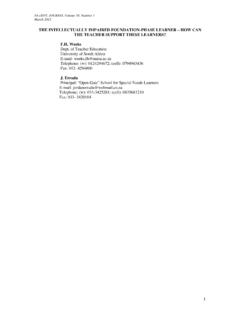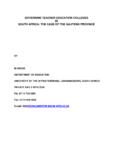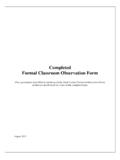Transcription of Teacher Enrichment Resource Packet for Inquiry Lab
1 Teacher Enrichment Resource Packet for Inquiry Lab Inquiry Lab Teacher Enrichment Resource Packet . States of Matter Matter is the stuff of the universe. Explore the different types of matter. How do they behave? How do they change from one state to another? Investigate these questions and examine some bizarre substances that seem to defy the laws of science. Learning Objectives: Learn about the different states of matter and the properties of each Identify common properties in and classify unknown substances Think it. Practice teamwork skills while collaborating on group activities Try it.
2 Contents Learning Objectives 1. Explorit. Background Information & Classroom Activities 2-4. Science Standards 5. Explorit Programs 5. This Resource made possible by Davis Waste Removal: 2009 Explorit Science Center Davis, California Teacher Enrichment Resource Packet for Inquiry Lab Thank you for choosing Explorit Science Center's Inquiry Lab program to supplement your ongoing science curriculum. Whether you use the program to kick off a new unit, wrap up a nearly completed unit, or purely to excite and interest your students in the wonderful world of science, advance preparation and follow up with your students are critical to achieving the greatest educational benefit from this unique science experience.
3 Explorit provides two resources to help prepare you and your students for the Inquiry Lab. First, simple logistics of the program are detailed in the confirmation letter. Second, this Teacher Enrichment Resource Packet outlines appropriate science content and processes to help you: successfully prepare your students prior to visiting Explorit;. participate fully in the Inquiry Lab yourself; and follow-up with your students back in the classroom. Background Matter is all around us. It surrounds us, interacts with us, and is us all of the time. Information Anything that takes up space is matter.
4 Even though matter is found all over the "States of Matter" universe, it only exists in five forms: solid, liquid, gas, plasma, and Bose-Einstein condensate. These forms are also known as the states or phases of matter. Solids are usually hard because they are composed of tightly packed molecules. Solids have a definite shape and volume. The molecules in a liquid, however, are more fluid. Consequently, liquids do not have a definite shape, only a definite volume. A liquid's shape will conform to the container that holds it. Gases are composed of high-energy molecules that are constantly bouncing around.
5 Gases do not have a definite shape until they are forced to take the shape of a container. Gases will also take on the volume of their container. Plasma consists of a collection of free moving electrons and ions atoms that have lost electrons. Although plasma is the most common state of matter in the universe, it is not that common on earth. Plasmas are found in fluorescent bulbs, neon lights, and in some display screens. A fifth state of matter, called Bose- Einstein Condensate (BEC), was observed in a laboratory in 1995. BEC occurs near absolute zero (-459 F) when atoms meld together to form a super-atom.
6 The properties of BEC are not yet fully understood, but scientists are performing exciting research on this new phase of matter. Changes in pressure or temperature cause matter to undergo a phase change. Melting, solidification (freezing), evaporation, condensation, sublimation, and deposition are phase changes that occur. Ice cubes melt at a certain temperature. Dew drops on plants evaporate as the sun heats them. Steam condenses into droplets as it cools. Deposition occurs when water vapor in the air loses heat page 2. 2009 Explorit Science Center Davis, California Teacher Enrichment Resource Packet for Inquiry Lab energy so quickly that it skips condensation and freezes to form frost.
7 The most popular example of sublimation is demonstrated with dry ice, that is, solid carbon dioxide. Frozen carbon dioxide sublimes into gas without passing through a liquid phase. The states of matter of the objects in the world around us are easily taken for granted. The universe would be a very different place if water, for example, did not act as a liquid is expected to act but instead flowed spontaneously out of riverbeds and glasses! Understanding how molecules behave in certain substances and how these behaviors can change is important for most scientists.
8 Meteorologists, physicists, chemists all scientists must understand the states of matter and the changes they undergo on some level. ACTIVITY #1 Dry Ice Exploration Classroom Background: Solid carbon dioxide is a fun way to study the process of sublimation. Activity #1. Materials: Dry Ice (available at many grocery stores), thick gloves, mallet (for breaking dry ice into pieces), balloons, dish soap, food coloring, fruit juice Instructions: Students will observe the sublimation process solid carbon dioxide undergoes at standard pressure and temperature on the earth.
9 What is the explanatino for dry ice's strange behavior? 1. Place a small chunk in a balloon. Tie up the balloon. What happens? 2. Add dry ice to water with food coloring and dish soap. 3. Place a piece of dry ice in fruit juice. When the dry ice has sublimated, the juice will be carbonated. Follow up: Have students brainstorm practical uses for dry ice. Safety noe: Dry Ice is extremely cold and can burn skin. Use caution with handling dry ice. Be sure to always wear thick gloves and cover dry ice with a towel when breaking into chunks to prevent pieces from flying around.
10 ACTIVITY #2 Design-Your-Own Experiment Classroom Background: Challenge students to design and conduct their own experiments Activity #2 using a small number of supplies. page 3. 2009 Explorit Science Center Davis, California Teacher Enrichment Resource Packet for Inquiry Lab Materials: worksheets for organizing experiment, water, boiling water, ice cubes, thermometers, cups, aluminum foil, saran wrap, paperclips, salt Instructions: Give groups of students a tray containing a small amount of the materials above. Have them create and conduct an experiement that investigates the states of matter using only these supplies.



